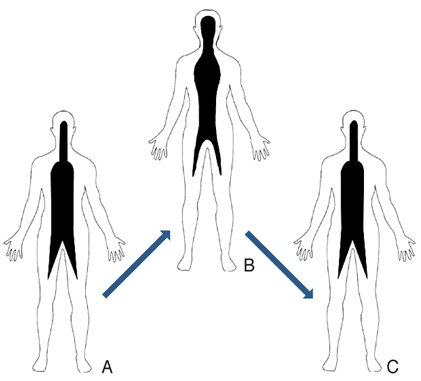J Korean Med Assoc.
2012 Jul;55(7):649-656. 10.5124/jkma.2012.55.7.649.
Introduction to aerospace medicine
- Affiliations
-
- 1Medical Division of Headquarter, Republic of Korea Air Force, Gyeryong, Korea. amekorea@gmail.com
- KMID: 2192727
- DOI: http://doi.org/10.5124/jkma.2012.55.7.649
Abstract
- Recent reports show that over 2 billion people are travelling via air every year, and the number of countries involved in space exploration is growing. Aerospace medicine, one of the specialty areas in preventive medicine, focuses on the clinical care, research, and operational support of the health, safety, and performance of crewmembers and passengers of air and space vehicles. Flight surgeons are military medical officers who play an important role in these tasks. The civilian equivalent of the flight surgeon is the aviation medical examiner (AME). Among the challenges that we encounter at high altitudes are a change in pressure, noise, spa-tial disorientation, and acceleration. We should also overcome microgravity and radiation in space. The common in-flight medical emergencies are abdominal pain, diarrhea, chest pain, coll-apse, asthma, diabetes, and allergic reactions. There is only one aerospace medical institute, the Aerospace Medical Center, in the Republic of Korea. The Aerospace Medical Association of Korea, established in 1989, continues to grow. In the near future, aerospace medicine will be an important part of preventive medicine in the Republic of Korea.
MeSH Terms
Figure
Reference
-
1. Han BS. An overview of In-flight medical care. Korean J Aerosp Environ Med. 2008. 18:69–77.
Article2. World Tourism Organization. Tourism highlights edition 2007. 2007. Madrid: World Tourism Organization.
Article3. World Health Organization. International travel and health 2008: situation as on 1 January 2008. 2008. Geneva: World Health Organization.
Article4. Kim JH, Park HB, Baek GS, Lee YH. Aerospace medicine. 1997. Seoul: Hanbit.
Article5. Oh JH. The understanding of aerospace medicine and history of Korean aerospace medicine. Res Vestib Sci. 2009. 8:87–89.
Article6. Bettes TN, McKenas DK. Medical advice for commercial air travelers. Am Fam Physician. 1999. 60:801–808.
Article7. Wu Y, Ding C. Effect of fighter cockpit noise on pilot hearing. Space Med Med Eng (Beijing). 1998. 11:52–55.8. Lim JK, Lee WY, Yang SM. The hearing loss in Korean air force pilots. Korean J Aerosp Environ Med. 2011. 21:34–37.9. Navathe PD, Singh B. An operational definition for spatial disorientation. Aviat Space Environ Med. 1994. 65:1153–1155.10. Davis JR, Johnson R, Stepanek J, Fogarty JA. Fundamentals of aerospace medicine. 2008. 4th ed. Philadelphia: Lippincott Williams & Wilkins.11. Rainford D, Gradwell DP, Ernsting J. Ernsting's aviation medicine. 2006. 4th ed. New York: Oxford University Press.12. Thornton WE, Moore TP, Pool SL. Fluid shifts in weightlessness. Aviat Space Environ Med. 1987. 58(9 Pt 2):A86–A90.13. Draeger J, Schwartz R, Groenhoff S, Stern C. Self-tonometry under microgravity conditions. Aviat Space Environ Med. 1995. 66:568–570.
Article14. Prisk GK, Guy HJ, Elliott AR, Deutschman RA 3rd, West JB. Pulmonary diffusing capacity, capillary blood volume, and cardiac output during sustained microgravity. J Appl Physiol. 1993. 75:15–26.
Article15. Fortney SM, Schneider VS, Greenleaf JE. Fregly MJ, Blatteis CM, editors. American Physiological Society. The physiology of bed rest. Handbook of physiology: a critical, comprehensive presentation of physiological knowledge and concepts. Section 4, environmental physiology. 1996. New York: Oxford University Press;889–939.16. Jennings RT. Managing space motion sickness. J Vestib Res. 1998. 8:67–70.17. Davis JR, Vanderploeg JM, Santy PA, Jennings RT, Stewart DF. Space motion sickness during 24 flights of the space shuttle. Aviat Space Environ Med. 1988. 59:1185–1189.18. Buckey JC. Space physiology. 2006. New York: Oxford University Press.19. Clement G. Fundamentals of space medicine. 2003. Dordrecht: Kluwer Academic Publishers.
Article20. Edgerton VR, Zhou MY, Ohira Y, Klitgaard H, Jiang B, Bell G, Harris B, Saltin B, Gollnick PD, Roy RR. Human fiber size and enzymatic properties after 5 and 11 days of spaceflight. J Appl Physiol. 1995. 78:1733–1739.
Article21. National Research Council. Radiation hazards to crews of interplanetary missions: biological issues and research strategies. 1996. Washington, DC: National Academy Press.
Article22. Robbins DE, Yang TC. Nicogossian AE, Huntoon CL, Pool SL, editors. Radiation and radiobiology. Space physiology and medicine. 3rd ed. Philadelphia: Williams.
Article23. Cucinotta FA, Manuel FK, Jones J, Iszard G, Murrey J, Djojonegro B, Wear M. Space radiation and cataracts in astronauts. Radiat Res. 2001. 156(5 Pt 1):460–466.24. Dowdall N. "Is there a doctor on the aircraft?" Top 10 in-flight medical emergencies. BMJ. 2000. 321:1336–1337.25. Ministry of Land, Transport and Maritime Affairs. The 12th enforcement regulations of civil aeronautics law. 2008. 05. 08.
Article26. Yoo BW. Travel medicine. J Korean Med Assoc. 2010. 53:501–509.
Article
- Full Text Links
- Actions
-
Cited
- CITED
-
- Close
- Share
- Similar articles
-
- Introduction to USAF School of Aerospace Medicine Training
- Introduction of Wright State University Aerospace Medicine Training Program
- Suggestion for the Developing Technology related to Aerospace Science in 21C: Recognition of Academic Significance of Aerospace Medicine
- Research Activities on Aerospace Medicine in Japan: Past, Present, and Future
- Aerospace Medicine Careers: Aerospace Medical Association



